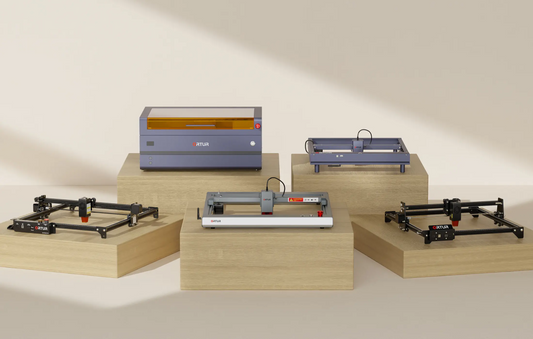
What is the Best LightBurn Setting for Photo Laser Engraving?
Share
If you’re working on a DIY project or a professional job with your laser cutter and engraver, understanding the best LightBurn settings for photo engraving is crucial. Setting up your laser cutter properly can ensure high-quality results, while incorrect settings may lead to burning or unwanted cuts. Many photo engraving tasks are handled by laser engravers, and LightBurn is a popular software used to control these machines.
Best Image Settings for Photo Laser Engraving in LightBurn
LightBurn is known for its flexibility and precision. It offers several features that help when working with images, such as image editing, laser path settings, and control over laser power and speed. This software is compatible with most laser devices like CO2, diode, and fiber lasers, and works well on common materials like wood, acrylic, and metal. To achieve the best photo engraving results, it’s essential to use the right settings in LightBurn. Here’s a step-by-step guide to help you achieve the best results:
Step 1. Convert to Grayscale
The first step for high-quality photo engraving is to convert your image to grayscale. Laser engravers work best with grayscale images because they can interpret darker areas as deeper engravings and lighter areas as shallower ones. Grayscale images help the engraver determine how much power to apply at different points.
In LightBurn, you can easily convert your image by:
- Going to the "Image Mode" option.
- Selecting "Grayscale" from the menu.
Step 2. Adjust Contrast and Brightness
The next step is adjusting the contrast and brightness of your image. This is important because Higher contrast enhances the definition of the engraving, especially for images with gradients or fine details. What's more, Brightness adjustments help avoid overexposing the light areas of your image.
Here’s how to adjust:
- Contrast: Increase the contrast by about 10-20% to make darker areas more pronounced. This will make the engraving stand out better.
- Brightness: Decrease the brightness slightly by -10% to -20% to avoid making the light areas too bright, which can cause overexposure.
Step 3. Use Dithering Techniques
Dithering is a technique that turns a grayscale image into a series of dots. This makes it easier for the laser to create smooth transitions between dark and light areas. LightBurn offers several dithering techniques that can improve the quality of your engraving by changing the laser's movement pattern.
The most common dithering techniques include:
- Jarvis: Creates a high-quality dither pattern that works well for photos with smooth gradients.
- Floyd-Steinberg: Produces a dither pattern that is often used for more complex images.
- Stucki: A high-quality dithering technique that’s good for finer details.
Best Laser Engraver Settings for Laser Engraving Photos with LightBurn
Once your image is ready, you need to configure your laser engraver settings in LightBurn to achieve the best photo engraving results. Here are the key settings to optimize your engraving process:
1. Power Settings
The power setting controls how strong the laser burns through the material. For photo engraving, you should start with a lower power level, as too much power can cause undesirable burning.
- Recommendation: For delicate materials like wood and acrylic, keep the power at 20-30% of your laser’s full output. If you’re using a laser engraver with less than 20 watts, you can start with slightly higher power, but always adjust based on the material type.
2. Speed Settings
The speed refers to how fast the laser moves across the material. A slower speed helps achieve deeper burns and more detailed engravings, but going too slow can over-burn the material.
- For wood, the recommended speed is 300-500 mm/min for engraving fine details, like text or logos.
- For acrylic, a slightly slower speed of 200-300 mm/min is better, depending on the material's hardness.
- For metals, fiber lasers often require slower feed rates of 100-200 mm/min to properly engrave photo details without damaging the material.
3. DPI (Dots Per Inch)
The DPI setting controls the engraving density. Higher DPI means more detail but takes longer to complete. For photo engraving:
- For wood carving with high detail, use around 300 DPI.
- For acrylic, 400-600 DPI works best for more intricate details.
A higher DPI gives more precision, but keep in mind that it also increases engraving time.
4. Scan Gap
The scan gap refers to the distance between the laser passes, measured in lines per inch. A smaller scan gap results in more detail but takes more time.
- For 300 DPI, the recommended scan gap is around 0.085 mm. This provides a good balance of detail and efficiency.
5. Image Mode
When setting up your photo engraving in LightBurn, change the laser mode to "Image" mode. This allows you to select different engraving techniques such as threshold, dither, and grayscale.
- The most suitable mode for photo engravings is dithering. This mode converts grayscale images into a collection of dots, which is ideal for smooth transitions and detailed engravings.
Tips and Tricks for Successful Photo Engraving
- Test on Scrap Material: Always test your settings on scrap material before engraving your final design. This helps you avoid wasting time and materials.
- Multiple Passes: Instead of doing a single heavy pass, consider doing multiple lighter passes. This helps prevent overburning the material and leads to cleaner engravings.
- Proper Focus: Ensure that the laser is properly focused to avoid blurry or uneven engravings.
Conclusion
Using a reliable laser engraver, such as the Ortur LM3, can make these settings easier to achieve. The Ortur LM3 features an ultra-precise laser, a next-generation Air Assist system, and a dual fan setup, which help maintain proper focus and avoid overburning while engraving photos. Plus, the additional accessories provide more flexibility and creative opportunities.



